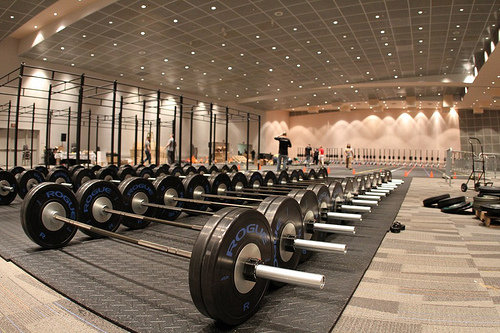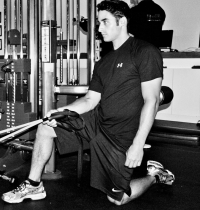Exercise Hacking – How You Can Lift 10-20% More in Your Workout Today


By Jonathan Goodman
A girl in my high school English class got 100% as her final grade. As I looked down at my 62% two things came to mind. The first was jealousy. The second was that the teacher should be fired.
English is not a finite. There are laws that govern it and universal truths but nobody has perfected the art and everybody can get better. Even the best writers are life long students of the art.
The study of the English language reminds me of weightlifting. We all strive to get better every day and nobody is perfect. While some of you have goals they are stops along the way. The pursuit of health is a lifelong journey both fraught with challenges and rewards. Continual improvement drives us, not perfection.
You found your way here so I’m guessing you’re already pretty good in the weight room. But how many of you have studied the art of weightlifting? I’m not asking if you read a bunch of blogs posts and books. I’m asking if you have studied weightlifting the same way that you study for a high school English class.
I have and I learned one thing…
Exercise can be hacked
By this I mean that it’s the nervous system that drives action. Muscles are slaves and do what they are told. This article is about improving your neural drive both acutely (during your workout today) and over the long-term.
This hack will train your body to move more efficiently and teach your nervous system to fire in a more synchronized fashion than before. The result is more efficiency and power. Do this and you can lift more weight and put on more muscle as a result.
What is exercise hacking?
I consider exercise hacking to be the art of re-learning a skill better than you knew it before. It’s understanding the nervous system and taking advantage of the way it works to generate more power. The first step is to understand how movement occurs and how the body learns skills.
A skill is the result of a series of precisely timed nervous impulses. The brain communicates to muscles by sending an electronic impulse called an action potential to the muscle. It does this along a nerve fiber. Once the action potential reaches the muscle it stimulates a signal for contraction and we have movement.
Each nerve fiber is covered by a fatty insulation called the myelin sheath. The more myelin a nerve has the faster the impulse is conducted, similar to the insulation of wires you might have in your house.
As an exercise is being learned the brain selectively myelinates all of the nerves involved. It decides which nerves have thicker insulation and which ones do not. Doing so coordinates the movement by conducting the impulses along the different nerve fibers at pre-determined speeds so that each muscle fires exactly how it should in an efficient manner.
The better you get at an exercise, the more efficient this system becomes. In the absence of disease or old age the body cannot de-myelinate. So the stronger you have reinforced bad habits the longer it is going to take you to learn new habits to override the bad ones your built up and vice-versa.
The following is a system to use during your workout today. This system has two effects. The first is that it will focus your mind on the exercise and have your nerves firing harder and more dedicated than they were before. The second is that it will dictate to your brain how to myelinate the nerves over time so performance continues to increase.
Your brain can only perform what it already knows
Wanting to get better is powerful for motivation but in my world of exercise hacking it won’t suffice. Your brain cannot plan. Instead it processes what it already considers to be a reality. The brain then retraces it’s steps and prepares accordingly. What you need is to convince your brain that the desired movement is already learned.
Before we begin you need an image of what the exercise should look like. So today, before you go to the gym, cut out a photo of the exercise you want to hack from a magazine or upload a video to your phone. Also, leave your music at home. You won’t need it today.
Your brain needs to have a clear and unabashed image of the exercise all throughout your training. You will be referring back to this image throughout the training session. The better the image the more effective your exercise hacking will be.
For the rest of this article I’m going to use the bench press as an example of the exercise you want to improve on. The same steps are followed for any exercise.
Upon arriving at the bench press here are the steps to follow:
Step 1: Sit down on the bench and look at the photo. Study it for 5-10 seconds.
Step 2: Close your eyes. Take 3 breaths for a count of 2s in and 4s out. Once you’re finished, picture yourself performing the exercise. The better you get at visualization, the faster you will learn. Pay attention to: the tempo of the lift, your tight grip on the bar, your chest and triceps stretching on the way done, and the tension and squeeze as the blood pools in your muscles for that brief second in between reps.
Step 3: Open your eyes and think about the movement. Identify one cue that will remind you throughout the press about the visualization. For me it’s to squeeze the bar. The harder I grip the more I can press and all else falls in line when I remember to do so.
Now that your brain knows what the exercise looks like it can figure out the cue that will work for you.
Step 4: Lift the bar. Repeat that cue over and over again throughout the lift, “squeeze… squeeze… squeeze…squeeze”.
How did the bench press feel? Already you should feel as if you are in a cave by yourself. Exercise hacking requires you to enter a zen-like state. You know you have achieved it when you no longer hear or pay attention to anyone or anything around you.
Step 5: Look at the picture or video you brought with you once again. Close your eyes and imagine yourself performing the movement. Squeeze your fists and create as much tension in your body as possible. Perform 2-4 reps in your head.
Step 6: Lift the bar yelling the cue in your mind, “SQUEEZE… SQUEEZE… SQUEEZE…SQUEEZE”.
After every set you perform follow the same sequence. Don’t just look at the picture you brought with you, study it. Then close your eyes and imagine yourself doing the exercise. Try to feel the muscles contract throughout your visualization.
Don’t talk to anybody throughout the series of sets or listen to music. Learn to train your mind and your muscles will follow.
The Forgotten Art of Lifting
Arnold once said, "the weights are just a means to an end; how well you contract the muscles is what training is all about." Muscles are slaves. They do what they are told. The nervous system is the driver. Stop paying attention to how the exercise looks and start paying attention to how the exercise feels.
References:
Yamazaki Y, Hozumi Y, Kaneko K, Sugihara T, Fujii S, Goto K, Kato H. Modulatory effects of oligodendrocytes on the conduction velocity of action potentials along axons in the alveus of the rat hippocampal CA1 region. Neuron Glia Biol. 2007 Nov;3(4):325-34. PubMed PMID:18634564
Fields RD. Imaging learning: the search for a memory trace Neuroscientist.†2011 Apr;17(2):185-96. Epub 2011 Mar 14. PubMed PMID:21403182
ABOUT THE AUTHOR

Jonathan Goodman is the author of Ignite the Fire: The Secrets to Building a Successful Personal Training Career. He started and still operates the Personal Trainer Development Center which acts as the largest free collaborative blogging website for personal trainers. Recently Jon stopped training clients in Toronto, Canada to focus on developing resources with the goal of improving the quality of personal training as an industry.
Website: http://www.theptdc.com
Facebook: http://www.facebook.com/theptdc
Twitter: http://www.twitter.com/jon_ptdc
